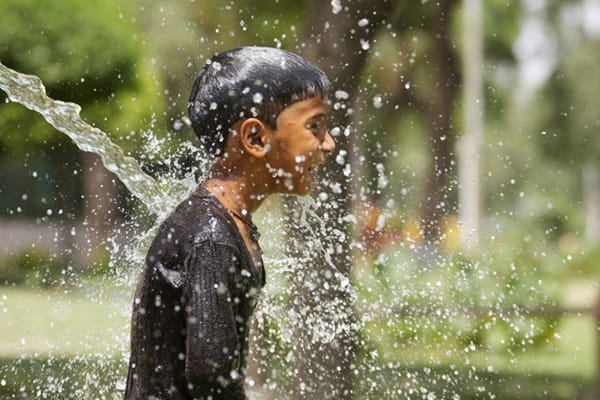Impact of heat waves on children

Mohammad Hanief
Climate change is raising global temperatures and causing historic heat waves. More countries are facing hotter days more frequently, with more intensity and for longer periods. The heat stress caused by exposure to heat waves can negatively affect health and well-being, especially for infants and young children.
In East Asia and the Pacific, around 243 million children are currently exposed to hotter and longer heatwaves than previous generations, putting their health and their education at risk. Children face significant health and developmental risks, including dehydration, heat exhaustion, and heatstroke, with prolonged exposure to such high temperatures putting children at risk of long team heath issues.
Extreme heat waves can have serious impacts on health in several ways. These events often occur during the summer months and can vary in intensity & duration depending on various factors such as geographic location, climate patterns, & weather conditions.

Higher daily peak temperatures and longer, more intense heat waves are becomingly increasingly frequent globally due to climate change. India too is feeling the impact of climate change in terms of increased instances of heat waves which are more intense in nature with each passing year, and have a devastating impact on human health thereby increasing the number of heat wave casualties.
Population exposure to heat is increasing due to climate change. Globally, extreme temperature events are observed to be increasing in their frequency, duration, and magnitude. Between 2000 and 2016, the number of people exposed to heatwaves increased by around 125 million.
While the effects of heat may be exacerbated in cities, due to the urban heat island (UHI) effect, the livelihoods and well-being of non-urban communities can also be severely disrupted during and after periods of unusually hot weather.
Heatwaves can burden health and emergency services and also increase strain on water, energy and transportation resulting in power shortages or even blackouts. Food and livelihood security may also be strained if people lose their crops or livestock due to extreme heat.
Cases of heat-related illness are rising with average air temperatures, and experts say almost half of those getting sick are children. The reason is twofold: Children’s bodies have more trouble regulating temperature than those of adults, and they rely on adults to help protect them from overheating.
Parents, coaches, and other caretakers, who can experience the same heat very differently than kids do, may struggle to identify a dangerous situation or catch the early symptoms of heat-related illness in children.
Children are more at-risk during heatwaves as their body weight contains more percentage of water.During heatwaves – Dehydration is quick to occur as the body loses more water than the intake. Since children’s sweat glands are not fully developed, this will lead to some trouble in regulating body temperature as compared to adults.? Another reason for children being at more risk during heatwaves is their body size.
Extreme heat poses unique risks at different stages of childhood. For example, babies and young children under age 5 are the most at risk of increased heat-related mortality and morbidity, while adolescents are more likely to experience exertional heat-related injuries.
Extreme heat can have serious effects on children’s health, mental well-being, education and even nutrition. Heat stress can lead to heat strokes and diarrhoea caused by dehydration. It can lead to an increased risk of chronic respiratory conditions, organ dysfunction like kidney failure, and chronic issues due to congenital defects.
Heat waves make droughts worse, adding to crop failure and threatening children’s access to food and water. Food insecurity caused by heat waves has severe impacts on child nutrition.
Heat waves are linked to lower school attendance. High air temperatures and lower hydration are known to affect children’s ability to concentrate. These can impact overall school achievements.
High temperatures are linked to increases in mental health problems in children and adolescents. Heat can lead to high stress and poor sleep. These in turn can make episodes of depression and post-traumatic stress disorder more likely to occur.
Our mental health is a fundamental part to our overall health and well-being. As a parent, you play a huge role in supporting your child’s mental well-being. Nurturing and loving care build a strong foundation, helping your child to develop the social and emotional skills they need to lead a happy, healthy and fulfilled life.
Heat Waves with longer duration pose more risks for children as they spend more time outdoors than adults for – sports and other activities – putting them at greater risk for heat injury.
Heat-related illnesses occur when exposure to high temperatures and humidity, which can be intensified by physical exertion, overwhelms the body’s ability to cool itself. Cases range from mild, like benign heat rashes in infants, to more serious, when the body’s core temperature increases. That can lead to life-threatening instances of heatstroke, diagnosed once the body temperature rises above 104 degrees, potentially causing organ failure.
Experts emphasize that drinking plenty of water, avoiding the outdoors during the hot midday and afternoon hours, and taking it slow when adjusting to exercise are the most effective ways to avoid getting sick.
Children’s bodies take longer to increase sweat production and otherwise acclimatize in a warm environment than adults’ do, research shows. Young kids are also more susceptible to dehydration because a larger percentage of their body weight is water.
Population ageing and the growing prevalence of non-communicable diseases (respiratory and cardiovascular diseases, diabetes, dementia, renal disease and musculoskeletal disease) means that populations are becoming more susceptible to negative heat impacts. Cities are not being designed to minimize the accumulation and generation of urban heat, with a loss of greenspace and inappropriate housing materials (for example, metal roofs) that amplify human exposure to excess heat.
Overall, heat waves pose significant risks to human health and well-being thereby highlighting the importance of taking preventive measures and staying informed during periods of extreme heat. By taking above mentioned preventive measures, you can reduce the risk of heat-related illnesses and stay safe during these times.
